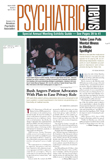APA’s 2002 annual meeting is being held in Philadelphia, where the organization that became APA was founded in 1844. Surprisingly, in view of its historical connection to this city, this is only the 14th of 155 meetings to be held there. Most fittingly, however, APA has celebrated the important milestones of its 50th, 100th, and 150th birthdays there.
In 1868, when the American Medical Association (founded in 1847) invited the Association of Medical Superintendents of American Institutions for the Insane to merge with it, the invitation was refused on the basis that the superintendents always held their annual meetings in a place that allowed visits to local asylums and where public attention could be drawn to the care of the insane people. Philadelphia met the requirements since the first provision for the insane in the American colonies was furnished by the Pennsylvania Hospital in 1752; the Friends Hospital was established in 1817. These two facilities and the Insane Department of the Alms House (Blockley) were always open to the superintendents during the annual meetings in Philadelphia.
On the evening of October 15, 1844, 12 superintendents met with Dr. Thomas Kirkbride, the superintendent of the Pennsylvania Hospital, at his home on the hospital grounds. The following day the organizational meeting of the association took place at the Jones Hotel at Sixth and Chestnut streets. The objectives of the Association were to allow the superintendents to become acquainted with each other, to further communication about their experiences of caring for the mentally ill, to cooperate in collecting statistical information relating to insanity, and to help each other improve patient treatment, according to Walter Barton, M.D., in his 1987 book titled The History and Influence of the American Psychiatric Association (American Psychiatric Press).
The next Philadelphia meeting occurred in 1851 at the hall of the American Philosophical Society. Seventeen members, including five new members, attended. The meetings in 1860, 1867, 1876, 1880, 1884, and 1894 were held at the Continental Hotel and thereafter at the Bellevue Stratford Hotel in 1919, 1932, and 1944. The 115th meeting in1959 took place at the Trade and Convention Center, and in 1994 at the Pennsylvania Convention Center, where much of this year’s meeting will be held.
Membership grew steadily for the organization. In 1876, 56 superintendents attended the annual meeting. By 1894, the Association had opened membership to other physicians working with mentally ill people, and 99 members were present, including 49 newly selected physicians. By the 1932 meeting, the Association had 1,375 members; in 1959, that figure was 10,420; and in 2002, approximately 36,000.
Since its beginnings, the annual meetings always included visits to local mental hospitals, places of historic and cultural interest, and social events. At the first meeting in 1844 a visit was made to the Eastern State Penitentiary since members had an interest in the case of “insane” prisoners. Other early meetings included visits to the Girard College for Orphans, the U.S. Mint, and facilities for the blind and deaf. In 1880 Norristown State Hospital and the Women’s Medical College extended invitations to the members. In 1884 the state medical society hosted a reception at the Academy of Fine Arts. In 1919 Pennsylvania Hospital gave a luncheon for members, and a visit was scheduled to Valley Forge. In 1932 the Pierre DuPonts provided an evening of entertainment at their Longwood estate, and visits were scheduled to the Veterans Administration Hospital in Coatesville and to the Delaware State Hospital for the Insane in Wilmington.
APA’s centennial meeting in 1944 featured an address by Franklin Kirkbride, son of the founder, with a visit to the mansion where the 13 original founders had met on the evening of October 15, 1844. The American College of Physicians arranged an exhibit about psychiatry, joint meetings were held with the American Psychoanalytic Association, scientific and commercial exhibits were held, and motion pictures on psychiatric topics were shown.
At the 1959 meeting the Philadelphia Museum of Art exhibited rare prints of psychiatric interest, reunions of various training programs were held, historic tours of the city and environs were held, and the city government invited members to a cocktail party. The Institute of the Pennsylvania Hospital and Friends Hospital were still on the tour of local sites.
The scope of the annual meeting has expanded beyond anything the founding superintendents could have imagined. This year’s meeting will offer 99 symposia, 102 CME courses, 49 industry-sponsored symposia, 24 lectures, and hundreds of workshops, discussion groups, and other sessions. ▪
